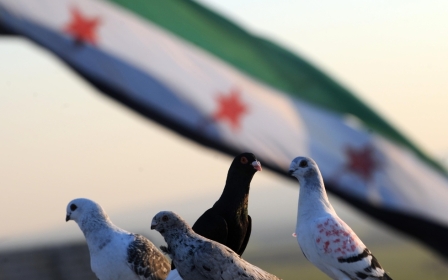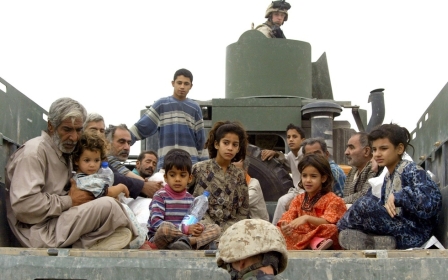Iran’s Middle East allies are crumbling

It is possible to say that the US invasion of Iraq in 2003 was the first opportunity that triggered the discussion about an Iranian expansionist project in the neighbouring region. Less than two years earlier, the US had brought down the Taliban regime in Afghanistan, which was a source of major concern for Iran.
Tehran was welcoming of the war on the Taliban – to the extent that the Khatemi government provided the assistance it could to the American war machine and to Washington's friends in the Afghan northern alliance.
Then came the American war on Saddam Hussein's regime, supported by the Shia exiled forces that were closely associated with Iran. It was said at the time, and it has turned out to be true to a large extent, that the Bush administration had waged two major wars in the Muslim world in order to effect a substantial change in the strategic environment of the Islamic Republic of Iran.
This does not, of course, mean that Afghanistan and Iraq led to a radical change in Washington's view of the Islamic regime in Iran, or that the American wars in both countries reflected some sort of a covert alliance between Washington and Tehran as some naive conspiracy theorists maintained at the time.
The fact is that the Bush administrations' view of Iran as a part of the “axis of evil” never changed. In reality, the architects of the American wars, who imagined that they were embarking on a project of reconstruction for the entire Mashriq, never relinquished the objective of bringing down the Islamic regime in Iran one way or another.
However, what happened is that the Bush war ended up serving the regime of the Ayatollahs. In Kabul, the new rulers did not conceal their desire to establish close relations with Iran (as well as with India) at the expense of Afghanistan's traditional relations with Pakistan, perhaps because the new Afghan rulers were under the impression that the Taliban were somehow still connected to the Pakistani agencies.
In Baghdad, the reins of power were gradually delivered to the Iranian allies of Shia political forces, and to a lesser degree to the Kurdish nationalists. Within a few years, and even prior to the withdrawal of the occupation forces from Iraq, Iran was able to bolster its penetration of the new Iraqi state institutions and to build various Shia militia organisations that reported directly to Tehran. In brief, Iraq was effectively turned into a huge Iranian colony.
Not far away, the Iranian influence was being manifested in different ways inside Lebanon and Syria. In February 2005, former Lebanese Prime Minister Rafiq al-Hariri was assassinated. Hariri never concealed his traditional Sunni inclinations and his desire to work for curtailing the hegemony of sectarian minorities over Syria and Lebanon. Although the Hariri assassination was accompanied by an extensive campaign of misinformation, increasing evidence was soon to indicate that the assassination was the product of a Syrian-Iranian concord.
The international reaction resulted in a temporary setback for the influence of Iran's allies as Syria was forced to withdraw its troops from Lebanon.
However, in a most daring endeavour to seize control of the Lebanese state, Hezbollah forces swept across Beirut in the spring of 2008 and dealt a painful blow to its foes, and the foes of Iran and Syria. As a result, the balance of power in Lebanon tilted massively in favour of Iran and its allies, emerging as the primary determinant of the Lebanese political situation.
At the same time, the relations between Damascus and Tehran continued to grow closer, bolstered by a series of agreements and mutual understandings, accumulating since the beginning of the 1980s, as well as by the rise of Iranian influence across the region. On the eve of the eruption of the Arab revolutions in early 2011, Iran was exercising unparalleled hegemony over both Iraq and Lebanon, while maintaining good relations with the Karzai government in Kabul and expanding the sphere of its alliance with the Assad regime in Damascus.
The Arab revolutions were both a good and bad omen for Iran. On the one hand, the Arab revolutionary movement presented, especially in its early phase, a progressive model of peaceful democratic change. It opened the way for the rise of the Sunni Islamic forces, which posed a very serious challenge to the repressive model of governance in Iran.
On the other hand, the Arab revolutionary movement, especially in its second phase, generated a power vacuum in countries such as Syria, Iraq and Yemen, providing Iran with the opportunity to make a new push forward in the region. Officially Iraq, represented in the Maliki government, had become entirely captive to Iran, while Iran's relationship with the Assad regime moved from the position of the sole regional ally to some sort of a mandatory power.
It did not take long before power delusions intoxicated the Houthis, Tehran's longstanding allies in Yemen, and drove them to seek full hegemony over the country. In one way or another, within just one decade, and without any tangible losses, Iran had become an empire, extending from the Gulf to the Mediterranean in the west and the strait of Bab Mandeb in the south.
In spite of mounting evidence that the Iranian influence was in decline, many concluded that the nuclear agreement would provide the Iranian expansionist project with what it needs to become an invincible power. So, where is the fault in the reading of the Iranian expansionist project, or in Tehran's own assessment of its power?
This, first of all, is the Middle East, the post-World War I Middle East, where power equations do not last for long and where the underpinnings of power keep changing just like quick sand. It is true that the Iranian expansion coincided with American failings in the Middle East, followed by a relative American withdrawal, as well as a decline of the regional Egyptian and Saudi influence; but it has also coincided with an active Turkish return to the neighbouring Middle East.
Additionally, it is true that the fall of the Taliban and Saddam regimes was quite swift, but it is also true that the Iraqi resistance to the occupation did not wait long before emerging, and that the Taliban were soon to regroup and lead the resistance against the occupation and its allies in Kabul. The problem with the Iranian expansionist project, right from the start, was that it did not take into consideration the continuously changing nature of the map of power and influence in the region.
Secondly, the Iranians chose in most of their expansionist steps to stand by the minorities, whether political or sectarian, in the face of the majority, not only the majority in every single country but also the majority at the level of the region as a whole.
The peoples of the region were, for several decades, viewing Iran with admiration and sympathy, especially when Iranian policy was characterised with standing by the people and their aspirations. Yet Iran was changing rapidly, where nationalistic and sectarian ambitions replaced the policies of pan-Islamic solidarity. Iran encouraged the emergence of a sectarian hegemonic regime in Iraq, and put its entire weight behind the continuation of the hegemony of a sectarian and political minority over Syria and its people.
It also supported the foolish Houthi plot to seize control of Yemen. Without a single exception, Iran's regional policies were to generate civil wars and ethnic and sectarian cleansing, not to mention the tragic destruction of peoples and their resources.
Thirdly, the Iranian expansionist project has, to a large extent, lacked moral coherence and the values necessary for its justification. Iran did not need any propaganda machine in order to help it generate regional popular support when it sided with the forces resisting Israeli occupation in Lebanon and Palestine. However, Iran's expansionist image has been crowded with murderers, robbers and sick sectarian politicians, like Maliki in Iraq, Assad in Syria and the Houthi in Yemen.
With such an image, it was no longer possible for Iran and its allies, no matter how talented and ubiquitous its propaganda machine happens to be, to justify their policies. With the collapse of the moral foundations of its position, Iran has become an isolated power lacking any popular sympathy in the region. It has, consequently, become extremely vulnerable to any sudden change in the balance of power.
It is not surprising, therefore, after years of imperial expansionist dreams, to see Iran's ally in Damascus losing much of his control over Syria, and the rulers of Baghdad to lose their control over much of Iraq. Nor is it surprising to see the Houthis' delusions of seizing control of Yemen are falling like a house of cards. The fact is that the Iranian expansionist project stood right from the start upon brittle and shaky foundations.
- Basheer Nafi is a senior research fellow at Al Jazeera Centre for Studies.
The views expressed in this article belong to the author and do not necessarily reflect the editorial policy of Middle East Eye.
Photo: Senior Iranian cleric Ayatollah Ahmad Khatami delivers the weekly Friday prayer sermon at Tehran University on 27 May, 2011 (AFP)
New MEE newsletter: Jerusalem Dispatch
Sign up to get the latest insights and analysis on Israel-Palestine, alongside Turkey Unpacked and other MEE newsletters
Middle East Eye delivers independent and unrivalled coverage and analysis of the Middle East, North Africa and beyond. To learn more about republishing this content and the associated fees, please fill out this form. More about MEE can be found here.





